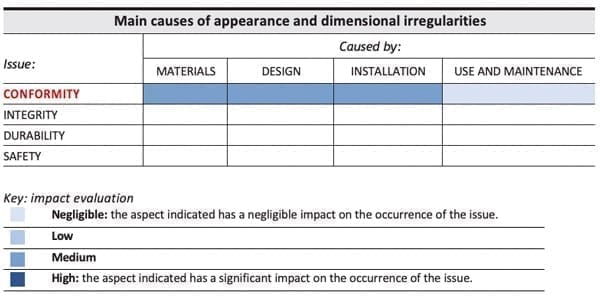Technical


An Italian standard provides guidelines for proper tiling | by Valentina Sarti
Section 5 of the standard UNI 11493-1 relating to the design, installation and maintenance of ceramic tiling defines the quality criteria and requirements that must be met by correctly designed and installed tiling. During or at the end of the installation process, but in any case before the floor is put into service, non-conformities between the installed tiling and the requirements of the standard may sometimes be observed, resulting in end-user dissatisfaction and in some cases leading to legal action.
Appearance and dimensional irregularities in ceramic tiling include the presence of height differences between adjacent tiles (lippage), surface issues and non-uniform joints in terms of width, orientation and grouting. After ascertaining that the tiling is non-compliant by performing the measurements and evaluations described in Section 5 of the standard, the next step is to determine the causes of the observed non-conformity.
Although the regularity of the tiles themselves is vital for the regularity of the finished floor tiling, it would be wrong to attribute responsibility for irregular tiling solely to the tiles themselves. Tiling defects may occur even in the case of tiles of excellent dimensional quality. Conformity of ceramic tiling with dimensional and appearance requirements is evaluated in accordance with standard UNI EN ISO 10545-2 by examining a sufficiently large sample of uninstalled tiles (considered representative for the batch of tiles used).
Along with dimensional checks, it may sometimes be necessary to perform chemical and microstructural analyses of the ceramic tiles. Although in some cases these tests may allow a given surface issue to be eliminated or prevented, it is worth considering carefully whether investigations of this kind are really necessary as they are not always relevant to determining irregularity defects.
To guarantee the flatness of tiling, the substrate onto which the tiles are installed must be regular in accordance with the requirements set out in § 7.3.5 of standard UNI 11493-1. These requirements are particularly significant in the case of fixing with adhesive and specifically when using thin large size tiles.
In the event of non-compliant tiling and a lack of data regarding the quality of the substrate prior to installation and the various layers making up the floor system, it may be necessary to perform destructive testing to obtain more information. However, if unevenness of the substrate is observed prior to installation, this must be rectified before the tiles are installed, for example by applying a levelling layer. In particular, the tile fixer must inform the client/site manager of the presence of any dimensional or surface defects in the substrate or tiles liable to jeopardise compliance of the finished tiling with standards and must suspend installation work, unless otherwise instructed by the client or site manager under their responsibility.
Fig. 1: Lippage between adjacent tiles – Fig. 2: Presence of surface issues
The main defects that may occur in terms of joints and grouting are non-uniformities of colour, width, orientation and filling. In these cases, the first thing to do is check that the grout manufacturer’s instructions have been followed, then consider whether the observed non-uniformities may have been caused by failure to remove spacers. In addition to the issues described above, specifying an installation layout with narrow and staggered joints may make certain dimensional deviations more visible, even if they are within tolerance and all other materials are compliant. This is particularly significant in the case of large and/or elongated shaped tiles. Requirements regarding joint widths are given in § 7.10.2 of standard UNI 11493-1.
To conclude, we have seen how appearance or dimensional irregularities in ceramic tiling may depend not only on the quality of the materials used but also on design and installation. For example, failure to specify levelling work in the case of excessively uneven substrates or specifying very narrow joints may lead to irregularities in the finished floor. Although it is almost never possible to quantify its real contribution to the dimensional and appearance quality of the tiling, installation certainly plays a vital role whereas cleaning carried out during and after installation has a negligible overall impact.
December 2019







